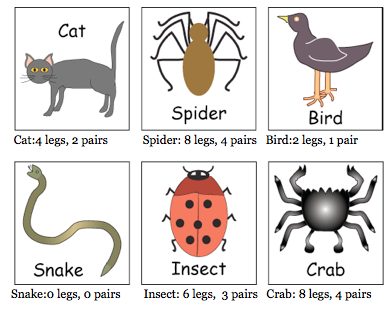Or search by topic
Number and algebra
Geometry and measure
Probability and statistics
Working mathematically
Advanced mathematics
For younger learners
Pairs of Legs



- Problem
- Getting Started
- Student Solutions
- Teachers' Resources
Paul sent in a solution for this problem:

Seonaid and Brid from St Andrew's explained how they knew how many pairs of legs each creature has:
We worked out how many pairs of legs these creatures had by dividing the number of legs by two because there are two legs in a pair.
Another solution is as follows:-
How many legs does each of these three creatures have?
Cat 2, Spider 8, Bird 2,
How many pairs is that?
Cat 1, Spider 8, Bird 1,
How many legs does each of these have?
Snake 0, Insect 6, Crab 8
How many pairs is that?
Snake 0, Insect 3, Crab 4
You may also like
Number Round Up
Arrange the numbers 1 to 6 in each set of circles below. The sum of each side of the triangle should equal the number in its centre.
Grouping Goodies
Pat counts her sweets in different groups and both times she has some left over. How many sweets could she have had?

